How to reduce noise in a call center.
Updated: 18 Oct, 2019Introduction
Controlling the noise level in a busy call center can be challenging.
For employees, multiple studies have shown that being subject to high levels of noise can cause increased stress and fatigue. This impairment can hamper motivation, lead to reduced focus and productivity loss. This can cause lower job satisfaction and potentially result in employee turnover.
For a customer, getting a call that you can’t hear clearly because of the call center’s background noise, can be a frustrating experience and ruin your impression of a company from the get-go. There can also be legal ramifications if callees can overhear conversations talking about other customer’s confidential data.

In this guide, you will get a crash course in acoustic management. We will cover a variety of approaches aimed at reducing call center noise and when possible include costs of potential solutions to help you budget wisely. If you are looking for ideas on how to reduce noise in your existing office, or want more insight and knowledge on how to evaluate a potential office space and it’s acoustics this is the guide for you.
While this guide is aimed at call center noise, the same techniques and approaches can apply to any noisy office workplace (such as a sales floor, or large open office).
The ABCs of Acoustics
When it comes to acoustic management, there are 3 main approaches, often referred to as the ABCs to help tackle noise. Call centres are inherently noisy, but by cleverly managing their acoustics, we can minimize the negative impact of that noise.
Absorb
Sound absorption is the most commonly used technique when it comes to reducing noise. With sound absorption, the aim is to minimize the amount of sound being reflected and reverberated and instead have as much as possible be absorbed. By doing so, we can prevent noise propagating and travelling around an office.
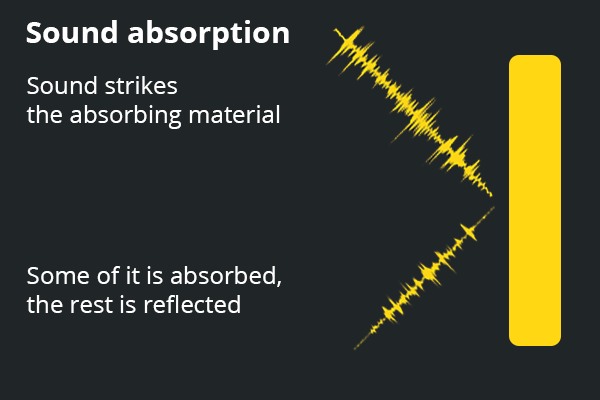

Unfortunately, most offices are full of materials that are terrible sound absorbers. Hard and smooth materials, which are typical for interior building surfaces, such as glass, wood, plaster, brick and concrete reverberate almost all sound while absorbing very little. Materials good at sound absorption (commonly referred to as acoustically soft) are generally soft, pliable, open-celled, porous or fibrous. For example carpets, wools and cork help to soften echos and reduce reverberations, as they absorb more sound then they reflect.
An important technical rating to keep an eye out for when evaluating potential purchases is the Noise Reduction Coefficient (abbreviated to NRC).
NRC represents how much of the sound is absorbed upon striking a particular surface. The value can range from 0 (reflects all sound, bad) to 1 (absorbs all sounds, great). For example, when sound comes in contact with glass it only absorbs 5% of the sound but reflects 95% of it back, so it has an NRC rating of 0.05.
Tip:
Keep an eye out if potential purchases have an NRC rating. The closer to 1 the better.
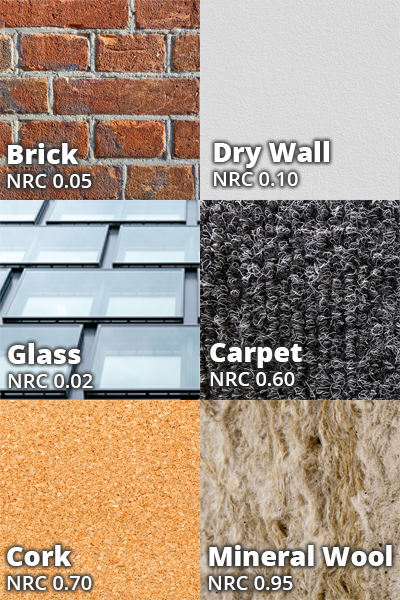
found materials in offices.
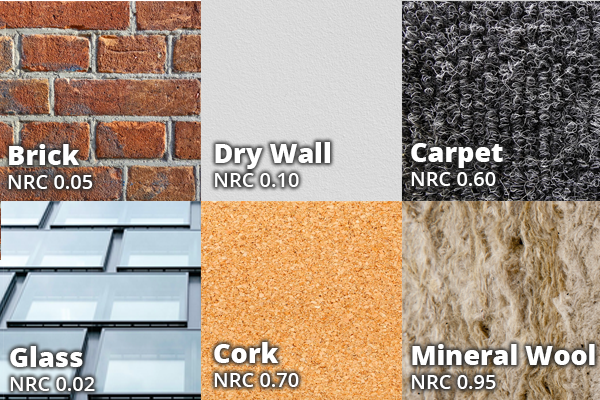
Block
Sound blocking (often referred to as soundproofing) works simply by putting a barrier between the noise source and listeners.
Similar to NRC, an important technical rating to evaluate how well something might block sound is the Sound Transmission Class (abbreviated to STC). STC represents how effective a material is in reducing the sound that travels through it. Unfortunately, its value is more complicated than NRC's 0 to 1. The STC rating instead represents the decibel reduction that the material provides. As guidance, see the table below, which describes the blocking effects of different STC ratings.
| STC | |
|---|---|
| 25 | Normal speech can be easily understood |
| 30 | Loud speech can be understood, normal speech heard but not understood |
| 35 | Loud speech can be heard, but is not intelligible |
| 42 | Loud speech is audible as a murmur |
| 45 | Loud speech is not audible |
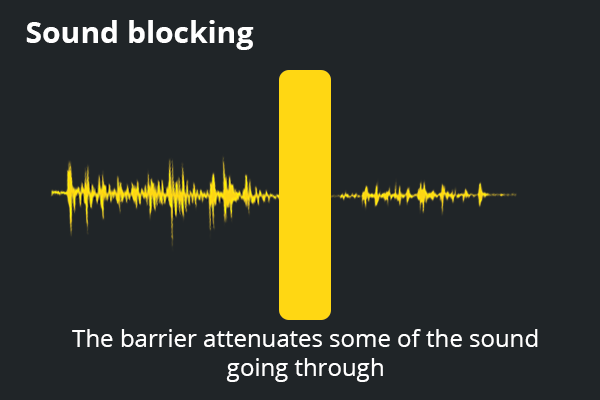

While a material may be very good at blocking sound, it may do so, by reflecting most of it (i.e. bad sound absorption). Depending on the situation, one may be more important than the other. For example, if a workplace is suffering from too much echo, you will need to look for products with a good NRC rating to help absorb the sound. On the other hand, if the problem is sound coming through a wall, such as a noisy kitchen area affecting a calling floor you need to look for products with a good STC rating.
Cover
Sound covering works by introducing ambient background sounds that mask over more distracting office noises (i.e. speech). While it may seem counter-intuitive, by reducing the intelligibility of other’s speech, it makes it less noticeable, and thus less distracting. Importantly, this can also help protect speech privacy by stopping callers overhearing and understanding other callers conversations.
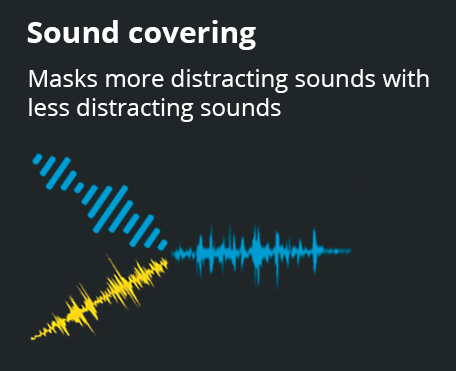

Environment
Layout
Let’s start by considering how we can optimize the office layout to reduce noise.
Reduce staffing density
If you have space, try reducing the caller density by spreading any phone agents further apart. If you are struggling on space and have dedicated web chat support agents, consider seating them between phone agents to reduce density.
Isolate noisy office equipment
Try and move any unnecessary noise sources away from the main calling floor. Equipment such as printers, fax machines, shredders, refrigerators, etc. If possible, try and move them into a separate room to block any noise admissions. If this isn’t possible, try to separate them with an movable acoustic partition (for example).


Desks
Depending on your existing desk setup, certain upgrades can go a long way in helping to reduce noise.
Acoustically divide desks
If your current desk layout uses long tables with no segregation, consider adding acoustic partitions (often called desk dividers) to isolate each caller from one another.
For maximum effectiveness when purchasing:
- Try and get desk dividers that are taller than the person sitting down and extend beyond the lip of a desk. This will separate agents by line of sight. Blocking the direct sound path from an agents’ voice to another agent’s headset, thus reducing noise.
- Look for partitions made from sound absorbing materials (keep an eye out for an NRC rating, the closer to 1 the better). Avoid materials like acrylic, or wood, as they just reverberate the sound.
Budget around $70-100 per desk (for example)
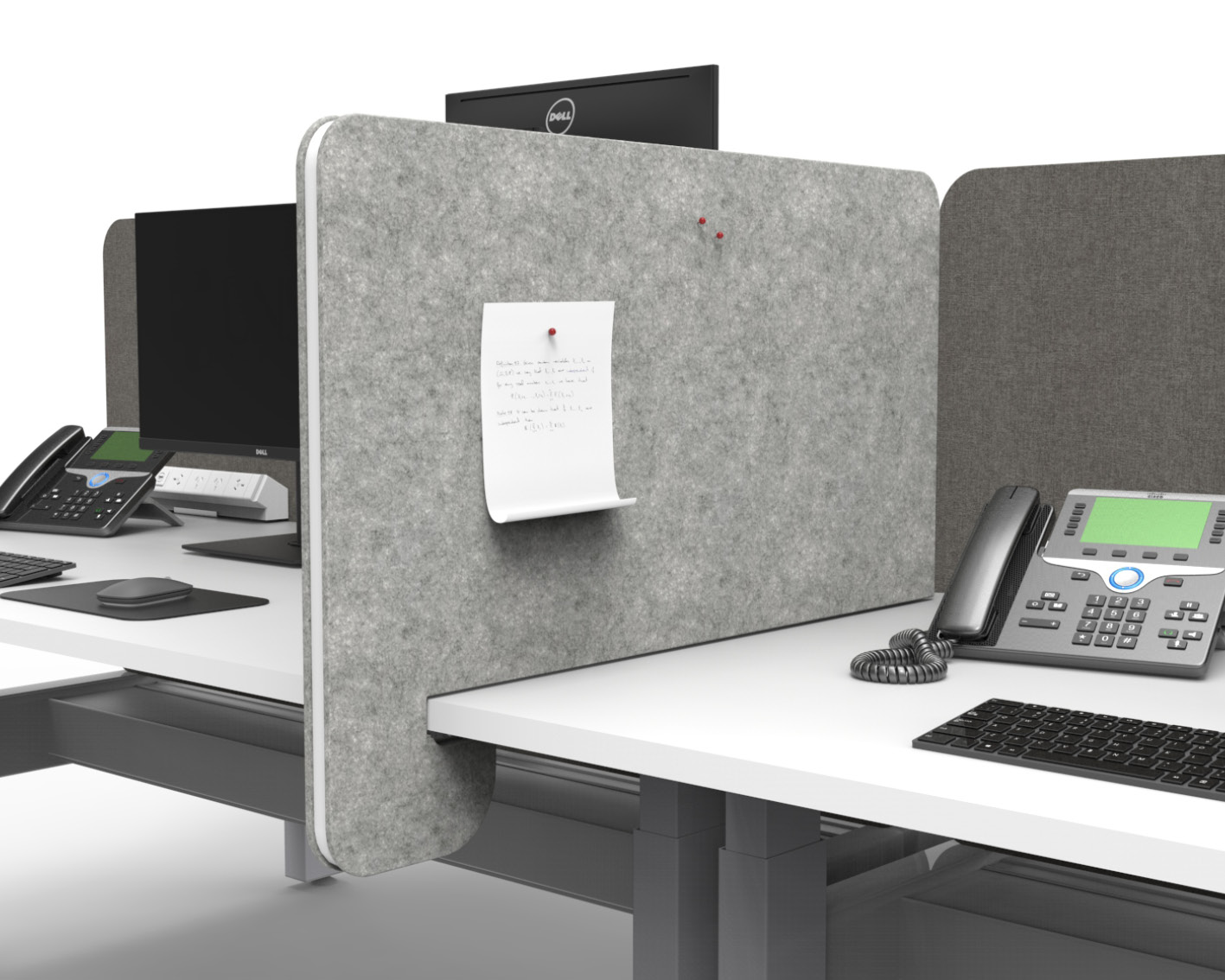

Add sound absorption to cubicles
If you have an existing cubicle/desk partition made from sound reflecting materials (such as wood, acrylic or glass) it may be worth covering them with acoustic foam panels to enhance their sound absorption. This option is more on the DIY side, but it can be more budget-friendly than having to replace your existing setup. With acoustic foam panels, the price often correlates to quality, so the higher the NRC rating, the more you’ll have to pay. Budget around $30 per desk/cubicle (for example).


Floors
Flooring takes up a huge surface area in an office and can have a considerable impact on noise.
Carpet
When it comes to flooring and noise reduction, carpet is your friend. Not only will carpeting help to reduce the noise of employees moving around but it can also help to soak up other office noises.
If your office has hard floors (tile, lament, concrete, hardwood) and your budget allows it, consider getting it carpeted (or if limited, carpeting just the calling floor).
Office carpet typically doesn’t come with an NCR rating. As a rule of thumb, the softer and fluffier the carpet, the more likely it’s sound absorption will be better. Try and get cut pile carpet as its open and thus larger surface area absorbs more sound than loop pile.


Carpet underlay can greatly improve the sound absorption and increase the longevity of a carpet’s life. Specialized acoustic carpet underlays do exist, and are typically made from a soft foam/rubber.
Rugs
If re-carpeting isn’t an option, consider strategically laying out rugs by callers, or in the loudest noise areas.
When choosing a rug, the same rules apply as carpet. Try and get the softest, most fibrous material and a good rubber underlay/anti-slip to further enhance the sound absorption.
Ceilings
Ceilings, like flooring, due to their huge surface area in an office can make a considerable difference to noise.
In your office, you’ll most likely find one of two types of ceilings, dropped or exposed ceilings.
A dropped ceiling (also called a suspended ceiling) is a secondary ceiling, hung below the main structural ceiling. They help to mask any internal wiring, HVAC/air conditioning systems, fire systems etc. They are typically constructed with a suspended metal grid that forms a spaced pattern of cells, where ceiling tiles or “panels” are dropped into place.
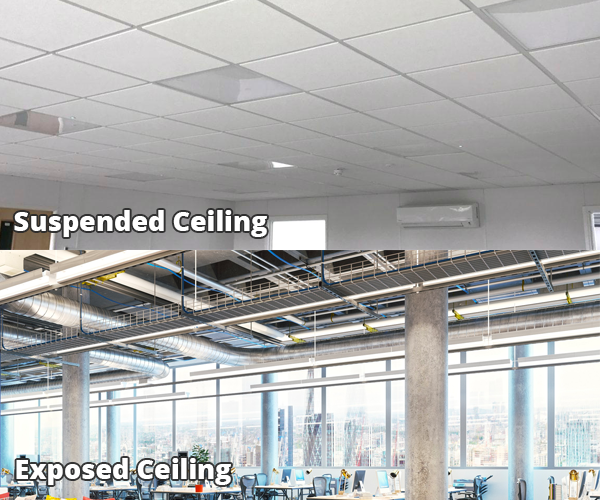

Acoustic ceiling tiles
Consider upgrading any conventional ceiling tiles to sound absorbing acoustic ceiling tiles. Acoustic ceiling panels are typically constructed with mineral wool insulation and a perforated surface that gives them excellent sound absorbing properties. Ceiling tiles exist, with NCR ratings greater than 0.85 (for example). Budget wise, expect to pay around $7 to $15 per ft² (for example).
One further consideration depends on the construction of the dropped ceiling and if there is a shared plenum. The plenum is the space between the hung ceiling and the structural ceiling above. Commonly in office construction, you will find that the partitioned rooms share a non-separated plenum. The downside of this is, that any sound that makes its way through the ceiling tiles, will reverberate off the hard structural ceiling and then spread the noise to other rooms in the office.


Due to this, when considering ceiling tiles, an additional important rating to keep an eye out for is the Ceiling Attenuation Class (abbreviated as CAC). CAC is how much sound is blocked of a suspended ceiling system over two adjacent rooms sharing a common plenum. Ratings typically range from 0 to 45 for ceiling panels. Anything above a CAC rating of 30 will block sound well.
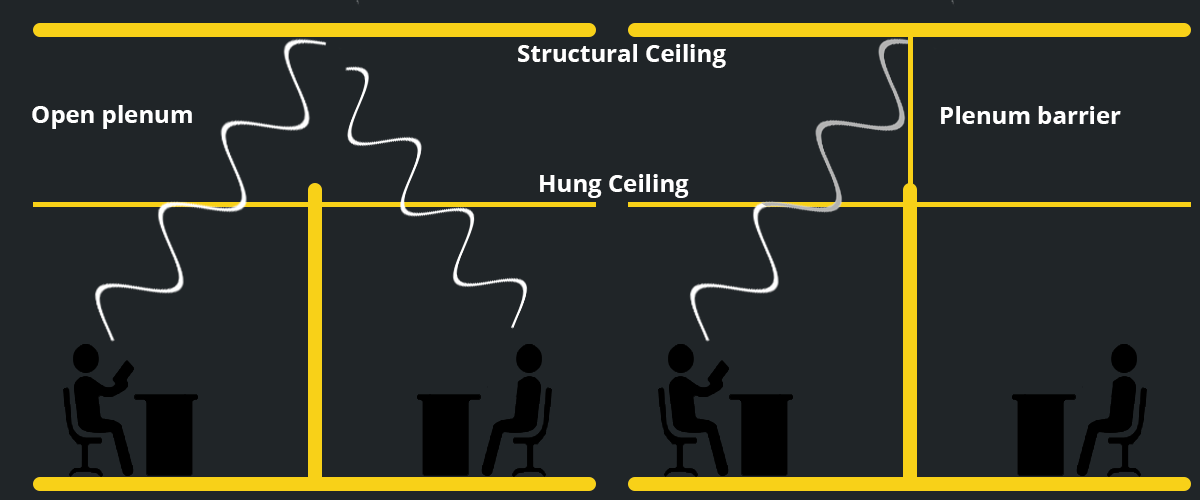
Alternativaly, plenum barriers can be an effective option to deal with this, however, their construction can be a bit more involved as they need to work around the already installed systems (e.g. HVAC, fire suppression, electrical wiring, etc).
Exposed ceilings
Exposed ceilings, as the name suggests, are ceilings where the structural and mechanical components are left exposed. While tall exposed ceilings can create a modern and stylish look for an office (think industrial warehouse aesthetic) when it comes to their acoustics, they can be problematic.
The hard surfaces of exposed ceilings can create an echo chamber, as they do little to absorb noise, instead they reflect back most of the sound.
Acoustics spray coatings
To combat this, a variety of acoustic sprays exists that can coat the ceiling with a textured sound absorbing material. Application is normally done by a specialist and the price varies per project. To maximise the sound absorption, you want as thick a coating as possible (however this will cost more).
This won’t achieve the same level of sound absorption as acoustic ceiling tiles in a dropped ceiling, however, you can still expect a considerable improvement (0.7 to 0.9 NRC if the coating is thick enough) compared to the raw ceiling.
Budget wise, this will vary based on your office space, but here are some companies that offer the service.
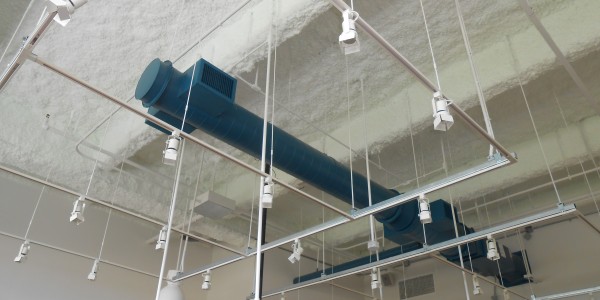

Acoustic baffles and clouds
Baffles and clouds are absorptive acoustic panels that are suspended from the ceiling. They can be economical, look stylish and most importantly be an effective way to reduce office noise.
So, what’s the difference between the two? Simply, clouds are hung horizontally, while baffles are hung vertically. When it comes to picking between the two approaches, both are effective options (this article goes into more detail if you are interested). As long as you ensure they have a good NRC rating (greater than 0.85) the deciding factor might come down to which complements the design scheme of the office better.
If for whatever reason you can’t cover the ceiling completely, strategically placing them near the loudest source of noise (i.e. the calling floor) is your best bet to maximize their effectiveness.
Budget wise, expect to pay around $25 per ft² (for example).
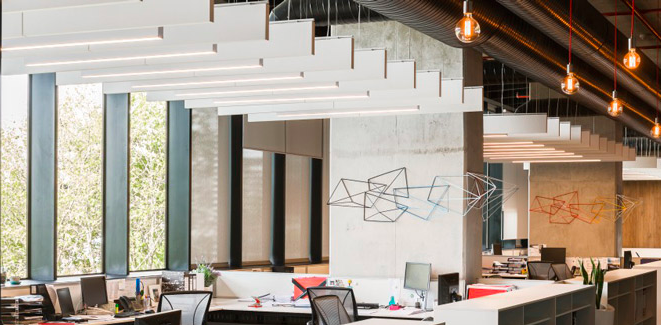
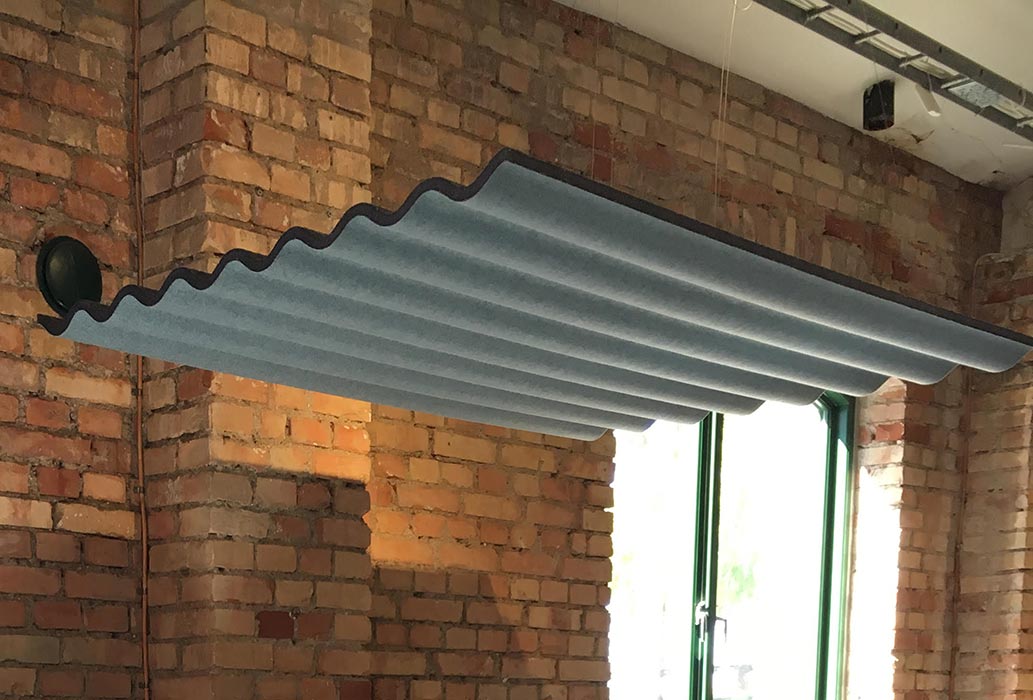


Walls
Another large surface in the office, another opportunity to reduce noise (you may of noticed a pattern here).
Acoustic panels
Acoustic panels are sound absorbing panels that can be mounted on walls. They come in all shapes and sizes so beyond just dampening noise, they can help add to the aesthetics of your workplace. If you want, you can even get custom images printed on them.
Before you purchase, just ensure they have a great NRC rating (>0.9). For maximum effectiveness, place them as close as possible to the noise source, i.e. by the calling floor.
Budget wise, depending on the design, expect to pay around $30 to $100 per panel (for example). If your budget is really limited, here is a great DIY guide on how to make high performance sound absorption panels from as little as $5.
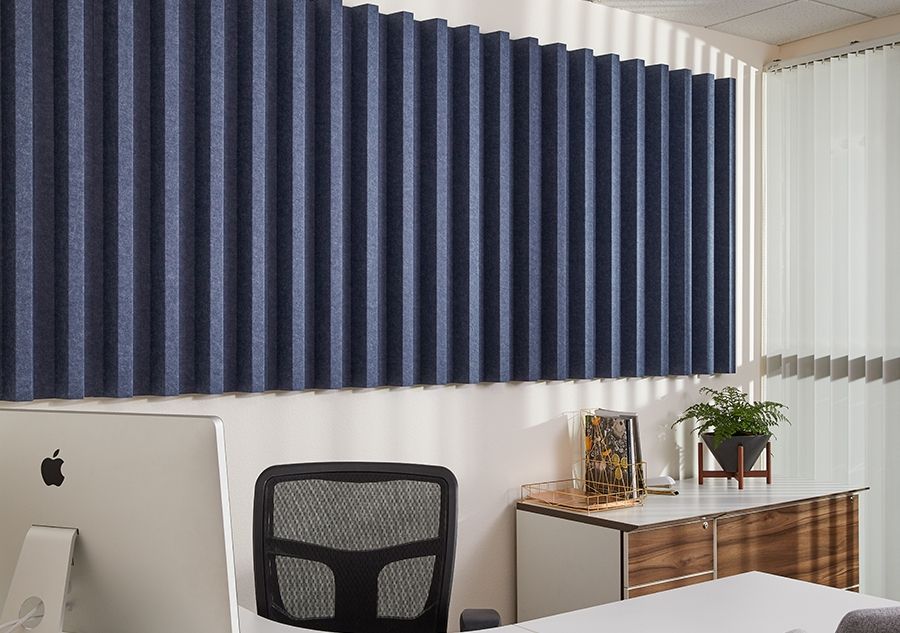

Equipment
Sound masking systems
Human brains are wired to listen out for speech, even if you are not consciously trying to do so. Overhearing another colleague’s conversation while trying to concentrate can be hugely distracting. This is often referred to as speech privacy, or how well an unintended listener can understand another person's conversation. A study from the University of Sydney have shown that insufficient speech privacy can be a major factor in overall workplace dissatisfaction for employees. Additionally, in a call center, there may be compliance, security or legal ramifications if callers on the line can overhear other customer's private information.
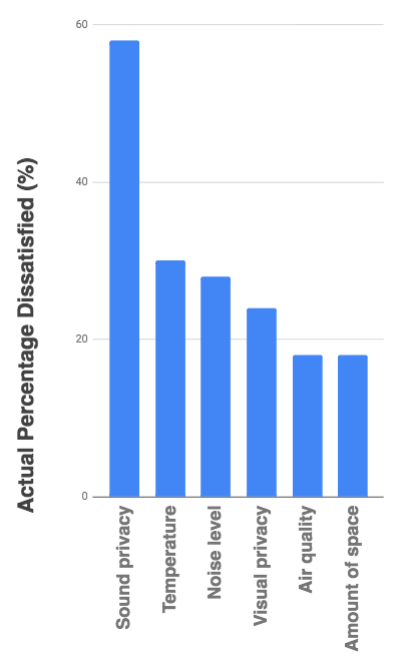
Sound masking helps improve speech privacy. A sound masking system works by introducing unobtrusive ambient background sounds. These cover over more distracting office noises and others' conversations. The ideal sound masking system, adds just enough ambient sound to the workplace to make speech intelligible, yet is still quiet enough to be almost imperceptible. If you'd like to hear an example of sound masking in action, this article has a great audio demo.
Note: Sound masking is not noise cancellation. Sound masking systems don’t make the environment quieter, rather they just reduce the perception of distracting noises.

When considering a sound masking solution, the levels of sophistication and price can vary greatly.
On the high-end, specialist companies exist which handle the design, layout and installation of a workplace speech privacy system. These complex systems can come with advanced features. Such as real-time adaptive sound adjustments, where the ambient sounds increase during active periods, and reduce again when noise levels drop. Professional sound masking kits can be bought standalone and should be installable by a handy man. Prices vary, but as a ball-park figure expect to pay around $1,000 for the equipment (only) needed to cover 400 ft² (37 m²) of office space.
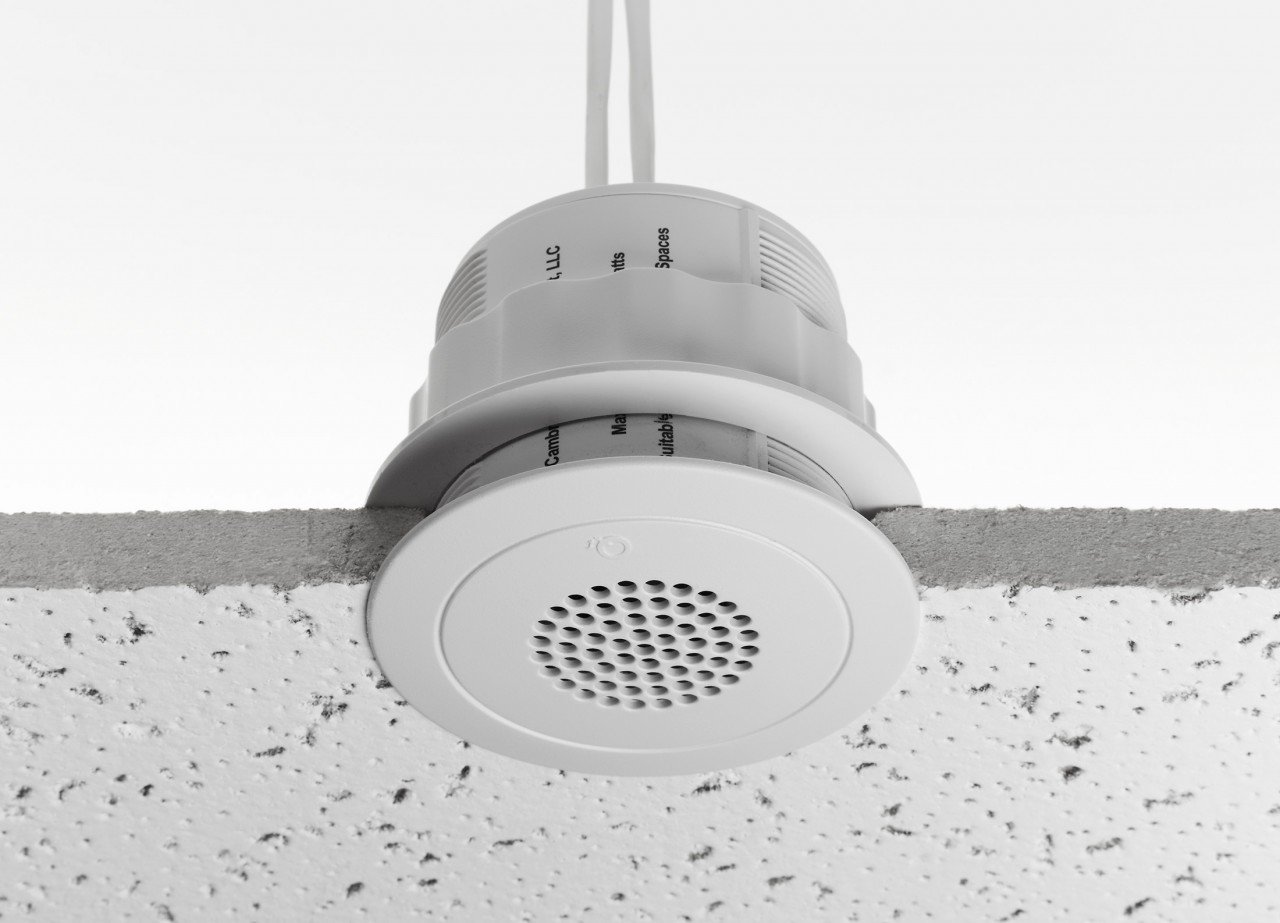

On the lower-end, standalone white noise machines can be purchased for around $50 (for example). These can be placed on an agent's desk, or nearby on the calling floor. They may not have the same advanced features as high-end sound masking systems (i.e. you'll need to manually turn them on and off) but they work in the same way and can be a low-cost and effective option to improve speech privacy.
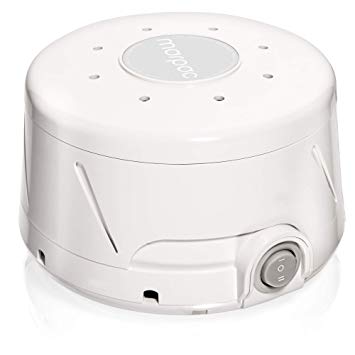

Software
Noise Blocker
We built Noise Blocker to help deal with a wide range of unwanted noises without affecting speech quality. Noise Blocker is a powerful, but easy to setup noise gate, that can be quickly customized to prevent office noise being picked up on an agent's headset. It works by effectively muting the microphone, when the agent is not talking. Not only does this get rid of background noises, but also enhances speech privacy, preventing callers overhearing other agent's conversations.
Noise Blocker's virtual microphone means it is compatible with any softphone call center software (e.g. RingCentral, Dixa, Zoho, CloudTalk, Zendesk Talk , CrazyCall, Aircall, etc).
Noise Blocker has a pilot program allowing your business to fully test it in your office environment and with your agents prior to any purchase. Budget wise, a Noise Blocker shared use license costs $39.99 per workstation. The license allows multiple agents to use the application on a single computer.
If you'd like to try Noise Blocker yourself, download it here and then follow the instructions below.
Note: If you prefer, you can watch a video of how to stop noises in Noise Blocker in under a minute.
Open Noise Blocker
- Under the “Noises” list, click on “Add”.
-
Hit “Record”, to record a sample of the noise. Hit “Play” to listen
back and confirm the recording.
If happy with it, label it then hit “Save” (or hit “Record” to re-record).
Repeat and record as many samples as needed for the offending noises (for example one background noise, keyboard, etc). -
Adjust the “Noise Reduction” and “Threshold” settings gradually so
that your voice still comes through, but the offending noises are
blocked.
Tip: Using "Listen to this Device" for audio feedback.
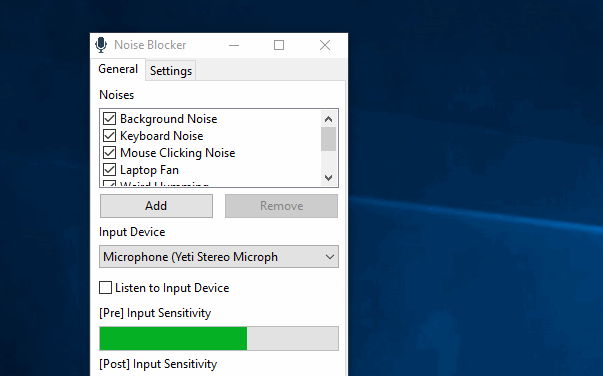
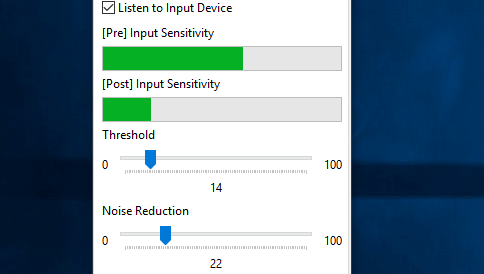
Then finally, in your calling software you we need to switch the input device to use Noise Blocker's virtual microphone.